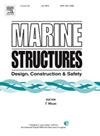Evaluation of hull girder ultimate strength for dry cargo inland vessels
IF 4
2区 工程技术
Q1 ENGINEERING, CIVIL
引用次数: 0
Abstract
Ultimate strength of sea-going ships is investigated in literature and addressed in the rules and regulations of classification societies, where detailed contemporary methods are defined. However, no systematic assessments or developed regulations for evaluating the ultimate strength of inland vessels have been introduced. This is concerning, considering that around 15,000 inland vessels navigate in Europe alone. These vessels are generally prone to longitudinal strength issues as they face specific design, operational and regulatory challenges, such as a large length-to-height ratio, shallow draught navigation, frequent grounding and overloading accidents, an older fleet and fewer regulatory requirements compared to sea-going ships. Therefore, this study presents a pioneering evaluation: it assesses ultimate strength of ten inland vessels, addressing this significant gap in literature. Five methods are employed for the calculation of ultimate strength: IACS defined progressive collapse analysis (PCA), three modified PCA methods according to different formulations for buckling of stiffeners, and a nonlinear finite element method. Moreover, maximum total bending moments are calculated in order to examine the margin between ultimate and service loads. Selected inland vessels are found to be particularly vulnerable to hull girder collapse, with some of them having extremely low or no margin with respect to hull girder collapse, largely due to the buckling of structural elements acting as a consequence of the selection of unique, dispersed and specific structural features. The research specifically emphasizes that vessels with longitudinal framing achieve higher ultimate strengths, offering greater structural safety against hull girder collapse.
干货内河船船体梁极限强度评价
海船的极限强度在文献中进行了调查,并在船级社的规则和条例中进行了处理,其中详细的当代方法被定义。然而,目前还没有对内河船舶的极限强度进行系统的评估或制定相应的规定。考虑到仅在欧洲就有大约1.5万艘内河船只航行,这一点令人担忧。这些船舶通常容易出现纵向强度问题,因为它们面临着特定的设计、操作和监管挑战,例如大的长高比、浅吃水航行、频繁的接地和超载事故、较老的船队以及与海船相比较少的监管要求。因此,本研究提出了一个开创性的评估:它评估了十艘内陆船只的极限强度,解决了这一文献中的重大差距。极限强度的计算采用了5种方法:IACS定义的渐进破坏分析法(PCA)、3种针对加劲筋屈曲不同计算公式的修正PCA法和一种非线性有限元法。此外,还计算了最大总弯矩,以便检查极限载荷和使用载荷之间的裕度。选定的内河船舶被发现特别容易受到船体梁倒塌的影响,其中一些船体梁倒塌的余量极低或没有余量,这在很大程度上是由于结构元件的屈曲,这是选择独特、分散和特定的结构特征的结果。研究特别强调纵向框架的船舶具有更高的极限强度,在船体梁倒塌时提供更高的结构安全性。
本文章由计算机程序翻译,如有差异,请以英文原文为准。
求助全文
约1分钟内获得全文
求助全文
来源期刊

Marine Structures
工程技术-工程:海洋
CiteScore
8.70
自引率
7.70%
发文量
157
审稿时长
6.4 months
期刊介绍:
This journal aims to provide a medium for presentation and discussion of the latest developments in research, design, fabrication and in-service experience relating to marine structures, i.e., all structures of steel, concrete, light alloy or composite construction having an interface with the sea, including ships, fixed and mobile offshore platforms, submarine and submersibles, pipelines, subsea systems for shallow and deep ocean operations and coastal structures such as piers.
 求助内容:
求助内容: 应助结果提醒方式:
应助结果提醒方式:


